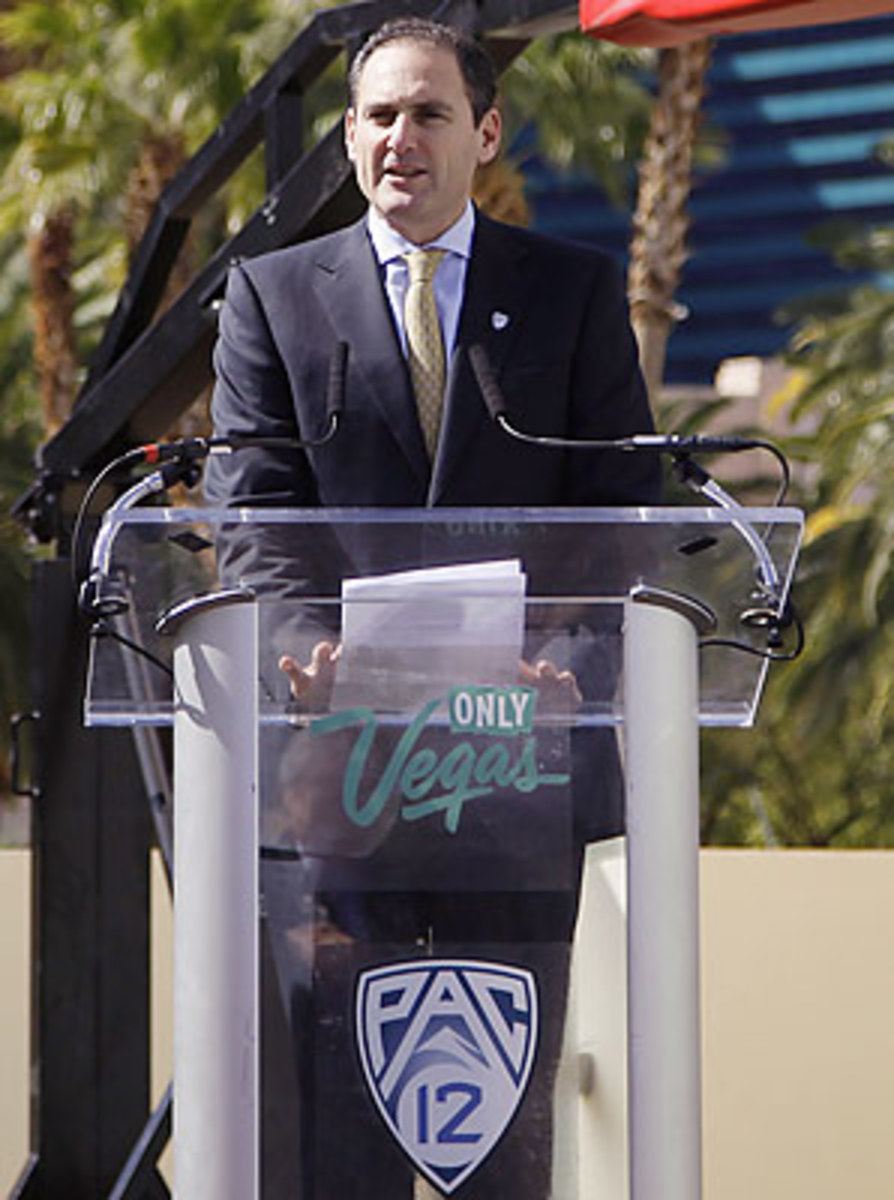
Pac-12 commissoner Scott solicits student input in playoff discussions
Pac-12 commissioner Larry Scott met with recent Stanford players Andrew Luck, Jonathan Martin and David DeCastro on Thursday to get their feedback on various proposals currently being discussed to overhaul college football's postseason. Last week Scott met with current USC players Matt Barkley, Robert Woods, T.J. McDonald and Devon Kennard, and he will do the same with a group of Utah players prior to their April 21 spring game.
"It's interesting for us to be able to give our opinion as student-athletes, or former student-athletes," said Luck. "We talked about how bowl games affect everything from our classes to finals, how much it takes our family to travel, the plusses and merits in our mind. And also what we thought of a playoff."
The 11 BCS commissioners and Notre Dame AD Jack Swarbrick have held several meetings this year to discuss possible changes to the system -- including the implementation of a four-team playoff -- for the next BCS contract, beginning with the 2014 season. They last met as a group March 26 in Dallas.
On Wednesday, USA Today published an internal BCS document outlining four models the commissioners are focusing on in determining the national champion. Three of them -- the current system with a few tweaks; the "original plus-one," in which the title game participants are selected after the bowls; and a seeded four-team playoff -- have been widely discussed. However, the fourth option, referred to as "Four Teams Plus," had not previously been disclosed. In that proposal, the Big Ten and Pac-12 champs would continue playing in the Rose Bowl, while the four other highest-rated teams would play games against each other, after which any of the group could be selected for the championship game.
Scott on Thursday downplayed the significance of the so-called "Rose Bowl Plan's" inclusion in the document.
"I wouldn't read into any one model on a piece of paper yet," Scott said from Stanford's campus. "The way to look at that is as a variant on a playoff within a bowl system. If you're going to have a playoff within the bowl system there are multiple ways to do it, and that would be one way."
Scott has previously stated his personal preference for an NFL-style model where higher-seeded teams host semifinal games on their home campuses.
His meetings with the players broached other subjects -- including a conversation between Scott and McDonald as to why the safety was suspended for a late hit last year -- but "because there's so much discussion going on about the college football postseason I've been trying to make a point to spend time with coaches and student-athletes to get their perspective," he said.
While the players expressed a range of opinions, the "common thread" was their desire for some form of playoff. "If you're a competitor, you want a chance to play for it on the field, versus being voted for. That was made loud and clear," said Scott.
The players had little opinion from a competitive standpoint about home sites vs. bowl sites but did share stories about missed class time at past bowls and concerns about difficulties for fans and families if asked to travel to multiple bowl or neutral sites. Classes at Stanford resumed the same day it played in the Jan. 3, 2011 Orange Bowl, and because they'd practiced through the holidays, many players went home first before returning to school.
"One thing I don't think he had heard before was the bowl games going into second semester of schools," said Luck. "Guys had missed school for a week, week and a half. As a quarterback, I was always a little frustrated about having a month off between games. You definitely lose a little rhythm with your receivers.
"As a competitor, who wouldn't want a playoff? Who wouldn't want a chance to be the best and settle it all on the field?" he said. "If that can be done in a way to keep the historic bowls happy, to keep the academic integrity of a student-athlete, that'd be awesome. But if it cant, hopefully there's a good alternative."
They commissioners will reconvene for the annual BCS meetings April 24-26 in Hollywood, Fla., where athletic directors, bowl and television executives will be in attendance for the first time since this latest round of discussions began. Ultimately, each conference's presidents hold the final say, which means annual league meetings in late May and early June will be particularly noteworthy this year. BCS Executive Director Bill Hancock has said a model will likely be chosen this summer, in advance of television negotiations this fall.
The player feedback "impacts my thinking a lot," said Scott. "As a former student- athlete myself, I think it should be in the front of our minds for what we want to do.
"We're going through various deliberations, it's not an entity that votes. Ultimately each conference has to agree on a model. It's a bit of a laborious process, but I think it's a bit healthy. No one will ever be able to accuse of not having thought about it enough."





